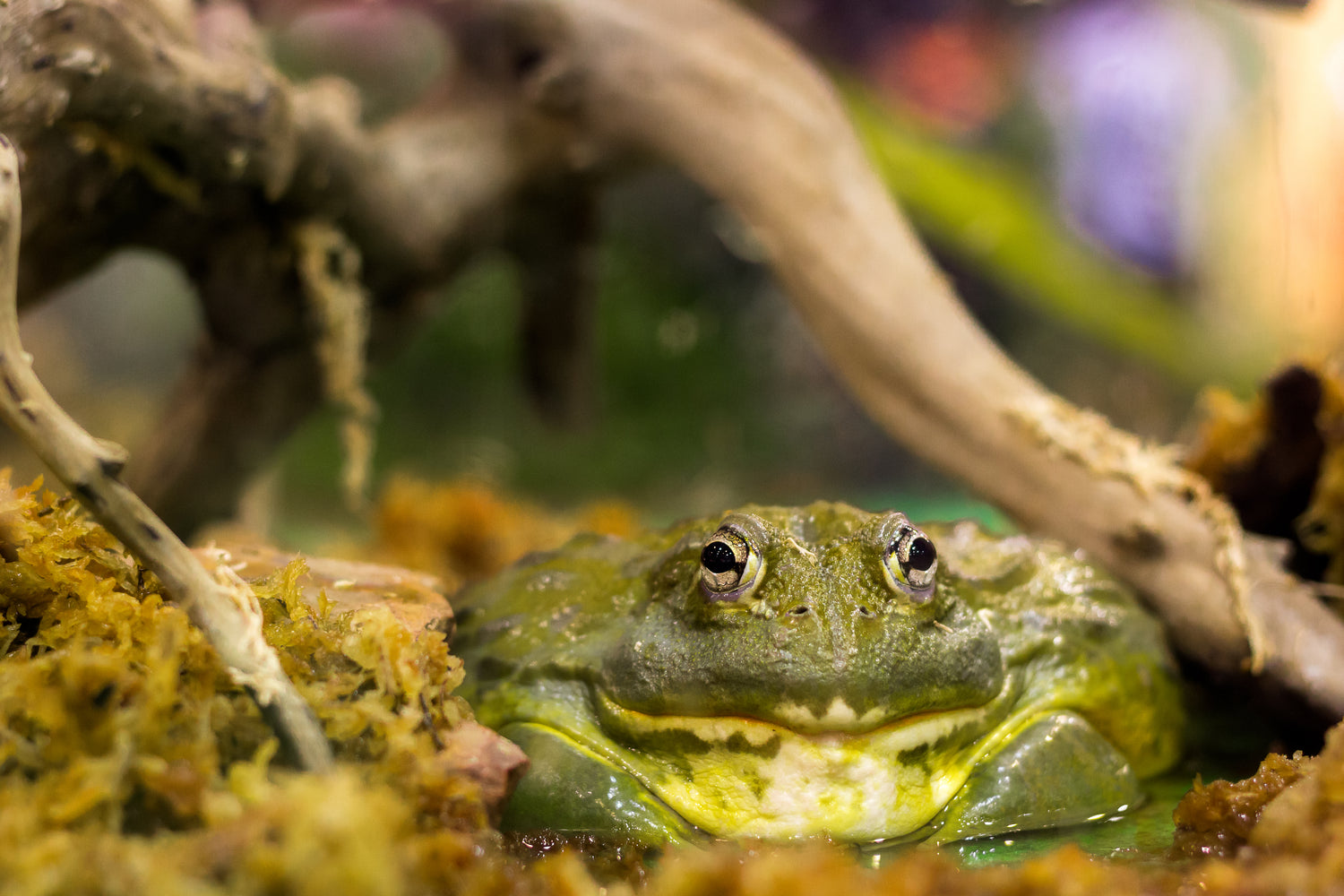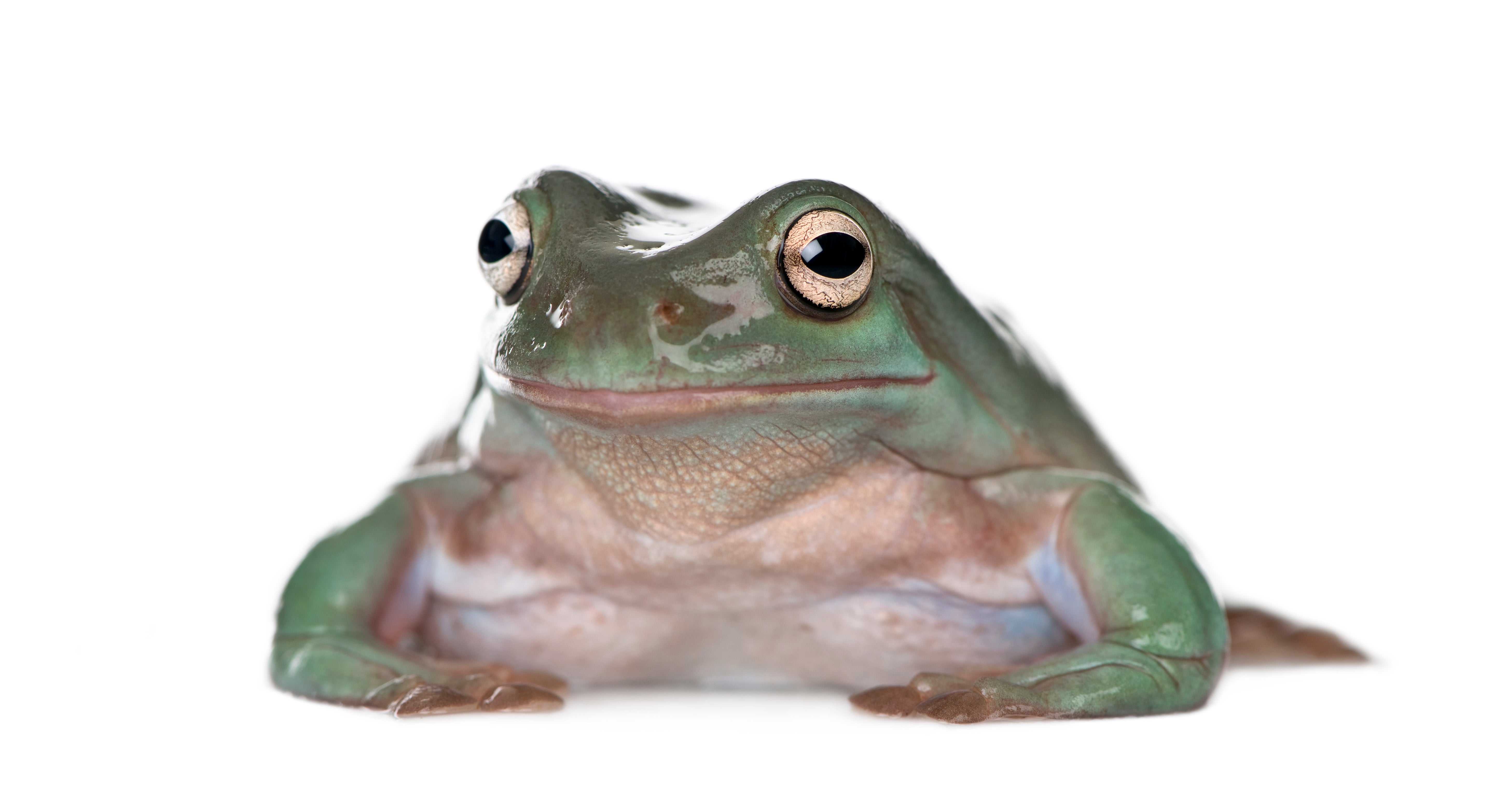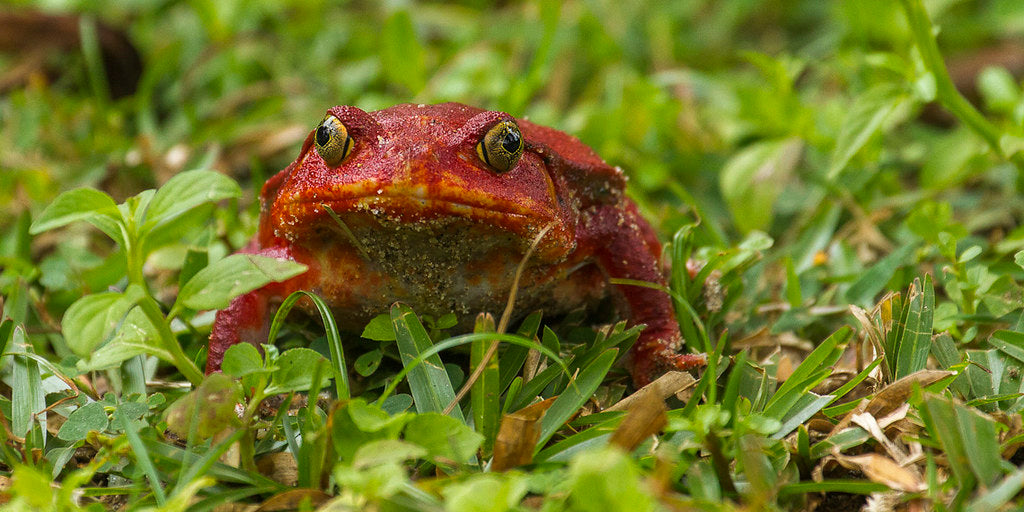Pixie frogs (Pyxicephalus adspersus) are large, diurnal, terrestrial amphibians found throughout southern Africa. They generally occupy savanna or shrubland for habitat, preferably near a body of water. They are also known as African bullfrogs.
Pixie frogs can grow up to 10” long, with females being about half the size of males. They have bulbous round bodies, relatively small heads, stubby limbs, and bumpy skin. They are generally olive green on top with a cream or yellow belly.
Although rather hardy compared to other frogs, pixie frogs are extremely large and have a powerful bite, making them an intermediate-level pet amphibian. With good care, they can live 30+ years.
How much space do pixie frogs need?
Although pixie frogs are quite sedentary as far as frogs go, they still need space to move around. The minimum enclosure size for one pixie frog is 40 gallons, or 36”L x 18”W x 18”H. Of course, larger is always better!
Cohabitation (keeping multiple pixie frogs in one enclosure) is not recommended, as these frogs are known to be food aggressive and cannibalistic.
Do pixie frogs need UVB?
They have demonstrated the ability to survive without it, but it’s still best practice to provide low levels of UVB lighting for optimal health and wellbeing. Providing UVB lighting to your frog gives them all of the vitamin D that their body needs, stimulates better appetite and activity, and generally allows them to be healthier than they would be without.
The best UVB bulbs for pixie frogs are:
- Zoo Med T8 Reptisun 5.0
- Arcadia ShadeDweller
The UVB bulb should be housed in a reflective fixture, and the frogs should not be able to get closer than 8” below the lamp. UVB is blocked by glass and plastic, so you can’t give your frog UVB by placing its terrarium in front of an open window. Also make sure that the fixture your UVB bulb is in does not have a clear plastic bulb cover. UVB bulbs decay over time, so don’t forget to replace your bulb every 12 months to maintain good performance.
Lights should be on for 13 hours/day during summer and 11 hours/day during winter to mimic natural seasonal cycles and promote better health through encouraging natural hormonal rhythms.
What basking temperatures do pixie frogs need?
Pixie frogs are ectotherms, which means that they rely on the temperature of their environment to help regulate their metabolism and stay healthy. If they’re too cold, they won’t have enough energy to stay active and digest their food. If they’re too warm, they can die from heat stress.
The enclosure should stay between 75-90°F during the day, with 90°F on the warm side and 75°F on the cool side. Temps may drop as low as 68°F at night. Your frog should always have opportunities to escape the heat as needed. Measure air temperatures with a digital probe thermometer, with the probe placed in the middle of the enclosure.
To warm the enclosure, use a couple of low-wattage heat bulbs on dimmers or a thermostat to make sure they don’t make things too warm. If they’re not warm enough, you’ll need a higher wattage bulb.
What humidity levels do pixie frogs need?
As amphibians, pixie frogs are very dependent on water! Pixie frogs should have access to both standing water as well as moistened substrate. That being said, the enclosure should not be kept sopping wet, as this encourages bacterial growth, which in turn will make your frog sick.
Ambient humidity should average around 60%, as measured by a digital probe hygrometer. If needed, misting your frog’s enclosure 1-2x daily with a sprayer will help create the right humidity levels. Using an automatic misting system can be helpful.
Also offer a large water bowl, large enough to easily accommodate the frog’s entire body and deep enough to come up to their chin.
Water used for spraying and soaking should either be bottled from a spring or treated from chlorine and chloramines with amphibian-safe water conditioner. Never use distilled or reverse-osmosis water, as this is harmful to amphibians!
What substrate is good for pixie frogs?
Pixie frogs require a thick layer of moisture-retentive substrate to help maintain healthy humidity levels. As an added perk, it also tends to make the enclosure more attractive. This substrate should have small particles and hold moisture well. Options include:
- Peat moss
- Zoo Med Eco Earth
- Exo Terra Plantation Soil
- Sphagnum moss
- Zoo Med Reptisoil
Pixie frogs enjoy digging down into their substrate until only their eyeballs are above the surface. For this reason, substrate should be at least 4” deep to facilitate this behavior.
If you are not using a bioactive setup, substrate should be replaced monthly in order to maintain good hygiene.
What décor can you use in a pixie frog terrarium?
While pixie frogs are quite sedentary, they are still likely to feel exposed and insecure in a terrarium with nothing in it except substrate. Décor options for pixie frogs include:
- leaf litter
- seed pods
- hides/caves
- cork bark
- rocks
- moss
- artificial plants
- misc. ornaments
Whatever you choose to use, make sure that the frog has cover to hide in so it can feel secure in its environment.
What do pixie frogs eat?
Pixie frogs are carnivores, which means that they need to eat animal prey in order to get the nutrition that they need. Here is a general feeding schedule to get you started:
- <3” long — food daily, as much as they’ll eat in 15 minutes
- >3” long — food 2-3x/week, as much as they’ll in in 15 minutes
Feeders should be at least slightly smaller than the frog’s head. Rodents should only be offered once every 2-3 weeks, depending on your frog’s body condition.
Insect options for pixie frogs:
- Black soldier fly larvae
- Crickets
- Discoid roaches
- Dubia roaches
- Earthworms
- Grasshoppers
- Hornworms
- Mealworms
- Silkworms
- Superworms
For best results, offer as much variety in your frogs’ diet as possible!
Supplements
Pixie frogs need vitamin and mineral supplements to enjoy optimal health. Feeder insects should be dusted with Repashy CalciumPlus LoD at each feeding for juveniles, and 1x/week for adults.
Do pixie frogs like to be handled?
Amphibians are generally not very handleable, but as far as frogs go, pixie frogs are more tolerant of handling than most. However, handling is still stressful for them, so it’s best not to handle them too often.
When handling your frog, put on a pair of disposable gloves, hold the frog’s body firmly but gently, and don’t keep them out of their enclosure for too long. Make sure to never drop them, as these frogs are heavy-bodied and can be seriously injured by a fall. Note that pixie frogs have sharp teeth and a powerful bite, so you may want to wear thick gloves under your disposable gloves as a precaution against injury.
One good way to bond with your frog outside of handling is to offer food via soft-tipped feeding tweezers!
*This care sheet contains only very basic information. Although it’s a good introduction, please do further research with high-quality sources to obtain additional information on caring for this species.




Leave a comment
This site is protected by hCaptcha and the hCaptcha Privacy Policy and Terms of Service apply.